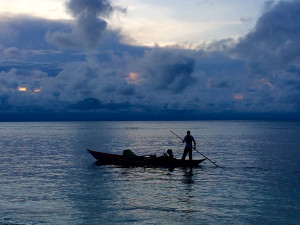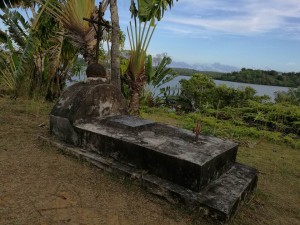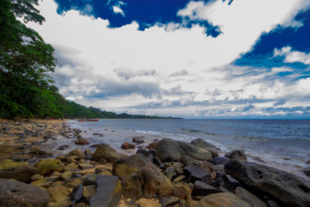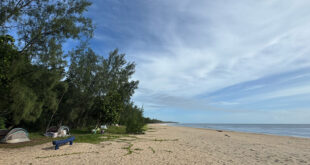In the late 17th century Madagascar became the epitome of piracy. The infamous republic of pirates, Libertalia, is said to have existed in the northeast of the island.
Everything is said to have started with the pirate James Misson. He is said to have been a Frenchman from Provence. During a stay in Rome, Misson, disgusted by the decadence of the Pope and his court, is said to have rethought his principles of life. Thereupon he stood up for the freedom and equality of all people. The crew of the French warship Victoire is said to have persuaded Misson to piracy under himself as captain. In West Africa, the Victoire captured a Dutch ship from slave traders. According to legend, they freed the slaves and brought them aboard the Victoire. The pirate Thomas Tew is said to have persuaded Misson to free more slave ships in the Mozambique Channel. Misson’s ship is said to have sunk together with himself during one of his liberation campaigns off South Africa.
The name Libertalia for the settlement point of the pirates on Madagascar comes from the Latin liberi, which means “free”. Libertalia was regarded as the epitome of a – by the standards of the time – free society, a form of democracy. A counter-draft to the monarchies common at the time. Libertalia followed the principle that every human being is born free and that the world should be divided fairly among the people who inhabit it. People of all colors, creeds, and political convictions should be able to live freely together. They even created their own language for their republic, a mixture of French, Dutch, English, and Portuguese. They also created their own flag – a white flag, in stark contrast to the black Jolly Rogers usually used by pirates. Elevated forts are said to have guarded the port of Libertalia.

Probably the Republic of Pirates is in fact simply a legend from the stories of Englishman Charles Johnson in 1724. The pirates of Libertalia are portrayed as Robin Hoods of their time, who rob the rich of their valuables and protect the poor. In reality, the situation in Madagascar in the 17th century was probably somewhat different. In fact, famous pirates such as William Kidd, Henry Every, John Bowen, and Thomas Tew occasionally moored their ships in the Bay of Antongil and off Nosy Boraha in eastern Madagascar. They used Madagascar to replenish their supplies and as a starting point for raiding the many merchant ships in the Indian Ocean. Large merchant ships, heavily loaded with spices, gold, jewels, and silk, often sailed between the ports of Africa, Europe, and Asia. Sailors of the captured ships often changed fronts and hired themselves out to the pirates.
One of the first pirate settlements in Madagascar goes back to the English pirate Adam Baldridge. He was on the run after a murder when he set up a small base on the island of Nosy Boraha in 1690. However, his settlement was far from the romantic ideal of Libertalia. In fact, Baldridge acted as a scalp dealer. He sent Madagascans as slaves to New York to get money and weapons from there. Baldridge soon controlled the entire port of the island. He subdued the native Madagascans and forced them to pay protection money. From the native women, he chose a variety for a kind of harem. In the following years, Madagascar was considered a pirate island. Baldridge offered pirates whose ships headed for St. Marie protection and supplies in return for high payments. Among his paying customers was the pirate Thomas Tew, who visited Baldridge in 1693. In 1697 Adam Baldridge was expelled from Nosy Boraha. The Madagascans of the island had found out that Baldridge had sold some of theirs as slaves and had sworn revenge. At the same time, the pirate John Hoar anchored in front of Nosy Boraha. Another pirate named Abraham Samuel fled from Nosy Boraha and sailed south on his ship along the coast.

The colony abandoned by Baldridge was soon captured by a merchant named Edward Welsh, but soon abandoned again. Another few years later the former pirate John Po came to Nosy Boraha. He traded with slave traders and pirates until his death in 1719. But the pirates never left St. Marie completely: The pirates’ cemetery St. Pierre still bears witness to the eventful life of the small island off Madagascar.
The Martinique native Abraham Samuel, the “King of Tolagnaro”, unintentionally founded a colony on the remains of a French fort in southern Madagascar shortly before the turn of the century in the 1690s after a shipwreck. This is exactly where Tolagnaro (Fort Dauphin) is located today. Samuel was fortunate that the wife of a deceased Antanosy king thought he was her returned son from a previous marriage to a Frenchman. Samuel did not disagree with this interpretation, because it meant that he was declared heir to the kings of the Antanosy people. In the following years Samuel led a kind of small Libertalia with a mixed population of native Antanosy and countless pirates from all over the world. He traded with passing ships, supported landing pirates with food and barter goods, and acted as a fence for stolen goods. Tolagnaro became for a short time a real competitor to the pirate base in Nosy Boraha. In 1699 the pirate Evan Jones visited Tolagnaro. In a cloak-and-dagger operation, Evan’s crew plundered the ship of the merchant John Cruger, who was actually a guest of Abraham Samuel. Samuel did not intervene in the conflict, however, because he had negotiated the captured ship as a reward with Evans. Without further ado, he also confiscated Cruger’s goods already brought ashore and convinced Cruger to switch to piracy as well. The “disappearance” of two other merchant ships in this way caused a trade collapse. Whoever set course for Tolagnaro had to be afraid to fall into the hands of the pirates as well. After Samuel’s death in 1705, the pirates disappeared again from Fort Dauphin. Their further fate remains unclear to this day.

Another pirate, the Jamaican James Plaintain, founded a settlement in the Bay of Antongil in 1720. He had just plundered an East India Company ship and divided the loot ashore. Plaintain proclaimed himself “King of Ranter’s Bay” and lived not far from the beach of the same name in Rantabe. Plaintain made friends with the native Madagascans, supplied them with weapons, and incited them to wars against other tribes after a neighboring king refused to give the pirate the king’s daughter as wife. As a result of the flourishing piracy in the Bay of Antongil, the Madagascans were able to buy weapons and ammunition from Plaintain, making the Sakalava tribes to the north and the Betsimisaraka tribes to the east coast dangerous enemies of the other Madagascans. The Betsimisaraka invaded Antakarana and Tsihimety, while the Sakalava enriched themselves on other neighbors. During the raids and clashes, numerous prisoners were taken prisoner and sold as slaves to Arab or European traders on the coasts. After eight years, Plaintain left Madagascar again. He took only one of his numerous women with him. He sought his new fortune in India. Still today there are rumors that Plaintain had buried his treasures in the bay of Antongil before he left Madagascar forever.
Most historians today agree that the existence of the legendary pirate republic of Libertalia is rather doubtful. However, pirates and their ships have definitely existed in Madagascar. That’s why adventurers in Madagascar are still searching for lost pirate treasures and evidence of the existence of Libertalia. And who knows – maybe Maroantsetra in the bay of Antongil was actually founded under the name Libertalia?
 MADAMAGAZINE Your Magazine about Madagascar
MADAMAGAZINE Your Magazine about Madagascar




